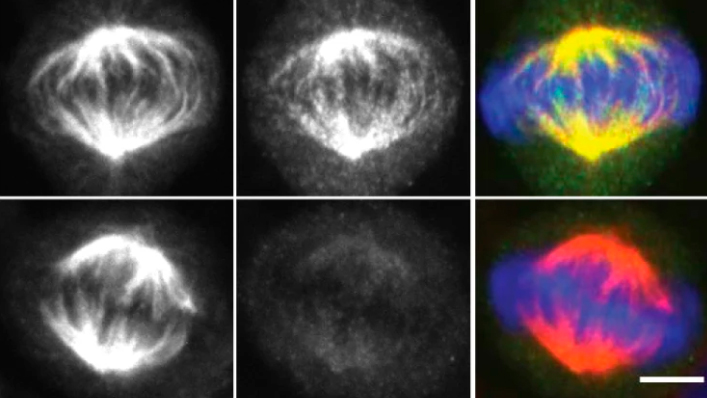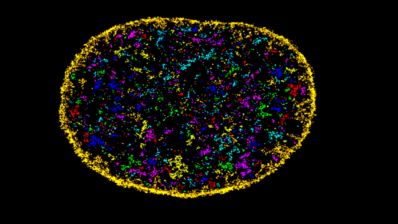The laboratory led by Isabelle Vernos at the Centre for Genomic Regulation (CRG) presents this immunofluorescence image of cell division where we can see the mitotic spindles that separate the chromosomes between the two daughter cells.
The image is part of the research carried out by Isabelle Vernos‘ group, which studies cell division and the function of microtubules, and in which they have been able to identify the role of Tubulin Tyrosine Ligase Like 11 (TTLL11) .
In the upper panel, unmodified zebrafish embryo cells are observed, and in the lower panel, we can see modified cells where the TTLL11 enzyme has been removed. Tubulin (the fundamental element of microtubules) can be seen in red, DNA in blue and PolyE (responsible for detecting free glutamate chains) in green.
The TTLL11 enzyme is responsible for attaching glutamate chains to microtubules (the skeleton of cells) to make them more stable and dynamic and to ensure that chromosomes are distributed properly between the two cells daughters. If the distribution of chromosomes is not equal, the cell can develop cancer or, in the case of embryos, a spontaneous abortion can occur. This is so important, that many chemotherapy treatments used today destabilize microtubules so that cancer cells self-destruct.
“Drugs that interfere with microtubule dynamics are already one of the most widely used first-line therapies against cancer”
Isabelle Vernos, CRG
The scientific team also analyzed TTLL11 levels in the Cancer Genome Atlas database, which contains more than 20,000 molecular features of about 33 types of cancer. They observed that in all cases of cancer there is a smaller amount of this enzyme, compromising cell division. “If this turns out to be a viable new therapeutic target, our findings pave the way for creating a new generation of drugs that are more precise and effective than conventional treatments,” concludes Vernos.
Would you like to see your photo here? Send images related to science or life to the PRBB to ellipse@prbb.org.
Zadra, I., Jimenez-Delgado, S., Anglada-Girotto, M. et al. Chromosome segregation fidelity requires microtubule polyglutamylation by the cancer downregulated enzyme TTLL11. Nat Commun 13, 7147 (2022). https://doi.org/10.1038/s41467-022-34909-y






